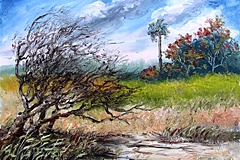
Welcome to Hemlock and Canadice Lakes!
Barns Businesses Cemeteries Churches Clinton & Sullivan Columns Communities Documents Events Time Line Fairs & Festivals Farm & Garden Hiking Homesteads Lake Cottages Lake Scenes Landscapes Library News Articles Old Maps Old Roads & Bridges Organizations People Photo Gallery Podcasts Railroad Reservoir Schools State Forest Veterans Videos
|
“Nature in the Little Finger Lakes” by Angela Cannon Crothers |
|
|
The Dance of Change By Angela Cannon Crothers September 2014 Trees are like dancers, shifting colors, giving a splash of bloom and brightness to the landscape, reaching up and outward in a seemingly imperceptiblility to a song too slow for our ears to hear, but heartfelt all the same. Humans are creatures of a faster pace, with short lives and quicker moves. Trees seem so solid and rigid, so permanent. Still, one can look at trees and witness sublime trunk and branching forms akin to a dancer’s pose. Sometimes two trees are entwined in a waltz or embrace, or one tree appears to be in a yoga-like position. Tree silhouettes show character, be it jovial or haunting, as well as form. But trees aren’t static beings, entirely frozen in motion. Trees can move. Trees bend to the wind, turn with the seasons, reach for the sun and dance through time. Trees also walk in what is better known as “range migration” when conditions change, and many of our familiar tree species are beginning to migrate northward with the warming of our climate. Trees move by means of seed dispersal variations that involve wind and animal mechanisms to spread their progeny. If a seed ends up someplace conducive to the soil, water, and climate needs of the species, it will grow. And so it does. As the earth warms, currently estimated to be at a rate of 5 to 6 degrees centigrade by the end of this century, tree species have to face the heat as well. Sugar maples are marching further north. So are the firs, pines, hemlock, and yellow birch, to name a few. According to the USDA, the rate of migration is about 50 to 100 hectors per century. Here in the Finger Lakes our autumns are a vibrant tapestry of red anthocyanin, orange carotene, and yellow chlorophyll pigments which are unveiled as each leaf dies to ready itself for winter. That is a grand dance all its own. Our sugar and red maples are most notable on our autumn landscape for their robust hues in dry years, and phoenix-type flames in wet ones, on the autumn landscape. We look forward, savor, and reminisce on such views. Life, though, is all about change and all about movement, from seedling to bud, from blossom to seed, from season to season, year to year, one life giving way to the next. Dominant species transform, sometimes because insect and parasites attack very specifically (that is how the elm, once a vital part of Seneca culture, was eradicated from the region). Some species are pushed out by invasives that overtake an area quickly. A majority of the eradications experienced these days are human caused: we accidently move seeds, parasites, and hitchhikers through the globalization of humankind. And we destroy habitat. We alter water patterns. We build and conquer, and submit nature to our needs. We change our environmental conditions through our actions, our movement, and our dance. About 400 million years ago our home was a tropical landscape with towering mosses of Lycopodium and horsetail Equisetum - then the size of trees - and an enormous inland sea. Later the mile-high glaciers, less than 10,000 or so years past, were followed by an unhurried transformation to a temperate forest wilderness and the trees we know today. And that was a gradual warming, much less than what we are facing now. The fact that maples and other species are here in this area during this time is a blessing for all of us to enjoy. But if trees are movers and adapters, then are we playing the gods of the planet with climate change, or can we be stewards of the earth instead? What sort of plants, crops, animals, and breathless array of autumn colors will we waltz to in time? In this long delicate movement of human evolution, what kind of dance do we wish to see, season by season and year by year?
|
||
|
Editor’s Note: Angela Cannon Crothers is a naturalist and writer who teaches at Finger Lakes Community College and with The Finger Lakes Museum. Here are some columns that she has written about the Little Finger Lakes. Her columns also appear in the Lake Country Weekender newspaper.
|
||
